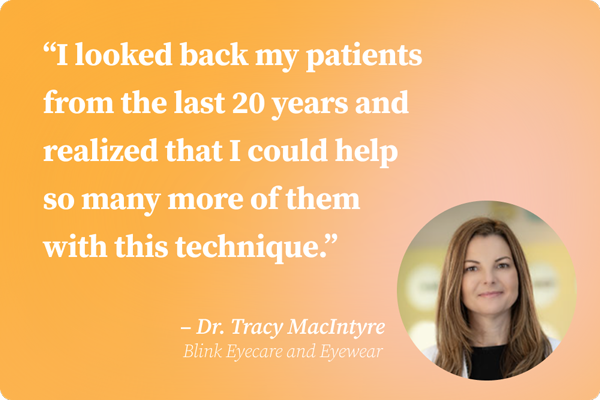Don't Miss the Signs of Subtle Phorias: 5 Questions to Ask Your Patients
Do you ever feel like your patients have symptoms that should resolve with a good refraction, but don't? Think migraines or trouble reading? It's frustrating to not have all the answers for your patients.
Matt Rosner
- 5 min read

Binocular vision is a vital component of our patient's vision, but is it receiving enough attention at your practice? Traditional comprehensive exams fail to detect subtle phorias, and the rise in the use of handheld devices, post-concussion vision issues, and new prism products is changing the phoria landscape. Optometrists must look beyond their current paradigm and explore new approaches to finding and treating subtle vision misalignment.
Today, patients visit their optometrist for an annual check-up, blurry vision, or to use up their insurance benefits before they expire. But most patients don’t realize they should visit their optometrist for the classic symptoms of BVD, including headaches, nausea, and car sickness. With patients unaware, optometrists are missing the opportunity to ask their patients about these exceedingly common symptoms and treat them. Asking the right questions and screening for BVD is no longer for niche practitioners – it is the right thing to do for all patients.
In this article, we will discuss how to inquire about BVD with your patients. We will focus on definitions of BVD, classic symptoms that patients are experiencing but don't know to tell their optometrist about, and a few of our favorite questions to include in your case history to uncover BVD. Then we’ll answer the $64,000 question: What to do with patients who have BVD?
What is BVD?
Binocular Vision Dysfunction (BVD) is a group of eye misalignment disorders that create significant symptoms. When BVD is present, the eyes have difficulty with synchronization and alignment, causing the brain to receive slightly different images from each eye and struggle to establish a fused image. This can lead to symptoms such as migraines, motion sickness, nausea, and much more.
BVD goes by many names, such as Convergence Insufficiency, Accommodative Insufficiency, Vertical Heterophoria, and Computer Vision Syndrome, but they all have the same underlying problem: subtle misalignment of the two eyes. This can cause patients discomfort, frustration, and limitations in their daily lives.
Sadly, patients are often more aware of their BVD symptoms than their optometrist. In fact, most patients are not aware that optometrists with the proper training can treat migraines, dizziness, and anxiety. These symptoms are typically treated by neurologists, ENTs, psychologists, or psychiatrists. As an optometrist, you have the opportunity to uncover and learn to treat these symptoms from your exam chair.
To successfully identify and treat BVD patients, you must commit to adding a few new questions to your case history for every patient. You will want to set aside a few minutes to listen to patients' experiences and let them know that there is help available.
Okay, so what are the questions that you should be asking?
Want to fill your exam schedule with more specialty patients?
Learn how adding a NeuroVisual specialty can help differentiate your practice and increase your medical patient referrals.
Let’s look at a few key questions to start asking.
Do you experience regular headaches or migraines?
Although this may seem like a common occurrence for patients who have them, regular headaches and migraines are not normal, yet, they are present in a large percentage of BVD patients.
Do you dislike reading or find it takes a long time to read a page?
Slow or frustrated readers often have BVD. Reading and learning problems are often identified in children early in their schooling. Adults with these difficulties will avoid reading whenever possible. A strong dislike for reading, despite proper refraction and correction of myopia or presbyopia, can be a sign of a phoria.
Do you experience carsickness or anxiety on highways?
Carsickness is a common condition that affects around 20% of children, but it can also affect adults. In addition to nausea, some people may feel anxious or dizzy on highways and prefer to take side roads instead. In fact, many map apps have a setting that allows users to avoid highways altogether. If a patient mentions experiencing carsickness or anxiety on highways, it could be a sign of binocular vision dysfunction.

Do you consider yourself clumsy or klutzy?
Clumsiness is often associated with a lack of intelligence or being a goofball. However, clumsiness can be due to difficulties with depth perception from BVD and can be associated with other BVD symptoms like slow reading and bumping into objects or people. They're all connected!
Do your eyes feel tired or fatigued at the end of the day?
This is a common symptom among optometric patients. But if your patients report feeling fatigued or tired at the end of the day despite a proper Rx, it could be a sign of a subtle phoria making close-up work more difficult.
Pro Tip: Did you know that you can use the Binocular Vision Dysfunction Questionnaire™ (BVDQ) to test your patients for BVD before their exam? The test covers 35 different parameters and only takes 5 minutes. Learn more about the BVDQ Self-Test in our on-demand demo.
Download the BVDQ →
What should I do if my patients answer yes to one or more of the questions?
We won’t bury the lead here: Prescribing microprism is an effective way to help patients with symptoms of BVD. Assessing all your patients for BVD presents new opportunities to identify and help them with their life-limiting symptoms.
The Data Doesn’t Lie
The statistics show that these symptoms are linked to phorias and microprism can provide significant relief. For example, "Screening and treatment for vertical heterophoria using microprism lenses provided significant symptom relief for patients with headache, dizziness, and anxiety symptoms that had not responded to traditional treatments."
A clinical approach to microprism prescription reduces symptoms by an average of 80% in just two exams. This is a quick and effective way to provide relief to patients, without the use of special machines or vision therapy.
This approach quickly becomes a daily tool for optometrists trained in prescribing microprisms.

Choosing the Right BVD Treatment Method
Experts in Binocular Vision and Behavioral Optometry can focus on both vision therapy and prescribing prisms. While both methods can be effective, getting started hasn’t been historically easy. Most do not receive much binocular vision education in optometry school, leaving them to figure things out on their own with little support.
Optometrists can attend courses and conferences to build their skills, but this requires a significant investment of time, energy, determination, and patience. Time and resources are big obstacles for many optometrists looking to incorporate binocular vision into their practice.
This is where NeuroVisual™ Medicine comes in. It is a unique clinical approach to treating phorias and BVD that enables any optometrist to identify and treat patients with custom-fit microprism lenses. This approach provides an average of 50% symptom relief during the first exam and 80% relief by the completion of treatment. And you don’t have to endure years of training to become proficient!
Win with Subtle Phorias
With NeuroVisual Medicine, you can expand your scope of practice without having to purchase expensive equipment or have to patiently wade through years of training – our signature 5-day immersive training program enables you to quickly and confidently start a new microprism specialty in your practice.
Schedule a free demo to see if it’s the right phoria treatment approach and practice growth strategy for you!
